Jan. 2014 / Star-Telegram’s INDULGE Magazine & Life&Arts
Turning Over A New Leaf
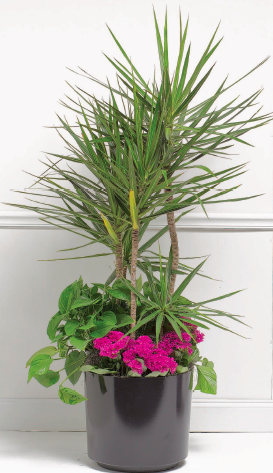
Superstars on NASA’s list of air purifiers, a red-edged dracaena marginata is accented with green pothos ivy and an eye-catching patch of kalanchoe blooms.
Go Green, Breathe Deep & Change The Winter Blahs To Ooh-Aahs With These Vibrant Houseplants
By Elaine Rogers / Photos by Ross Hailey
Even in Texas, where ice storms and rainy weather are frequently interspersed with sunny days, those brown lawns and shriveled flower beds still dominate our outdoor views, causing countless cases of the winter doldrums. A dainty planting of pansies may wave valiantly from a neighbor’s yard, but it’s a small comfort when the festive Christmas tree has been hauled out to the curb and your spring plantings are at least two months away.
The only reasonable course of action? Get proactive and offset your loss of greenery outside with a daily shot of interior greens. A mix of vibrant, colorful houseplants is the perfect reminder that winter doesn’t last forever, and there’s no shortage of plantscaping options for filling your favorite rooms with color, texture, fragrance and – better yet – oxygen-infused air.
Interior plantscapers specialize in bringing people and plants together, and while many focus on creating soothing environments in bank lobbies and corporate offices, others spread the love to residential interiors, as well. And why not? Humans intuitively gravitate to lush, natural settings and draw strength and mental clarity from our symbiotic relationship with nature. There’s even a technical term for this attraction – biophilia – that means “love of life or living systems.”
Our little green friends can help restore balance to our worlds (and lungs), cleansing the air we breathe; they also reduce mold spores, neutralize free radicals and add humidity to the air.
An interior zone is considered “properly planted” with one plant in a 10-inch grow pot for an 800-cubic-foot space (square feet times height), but experts recommend a more generous and easier-to-measure rule-of-thumb: 15 to 18 small houseplants per 1,800 square feet.
Now is the time to quit pouting about those past-their-prime fall houseplants that have been dropping leaves faster than you can say “flower power” and start envisioning a new interior winterscape rich with color, texture and air-cleaning goodness. Keep NASA’s list of top performers in mind as you eye various dead zones in your home, and check out these spectacular and special planting suggestions from the plantscaping pros at Fifth Avenue Greenhouses, Southern Botanical and Calloway’s.
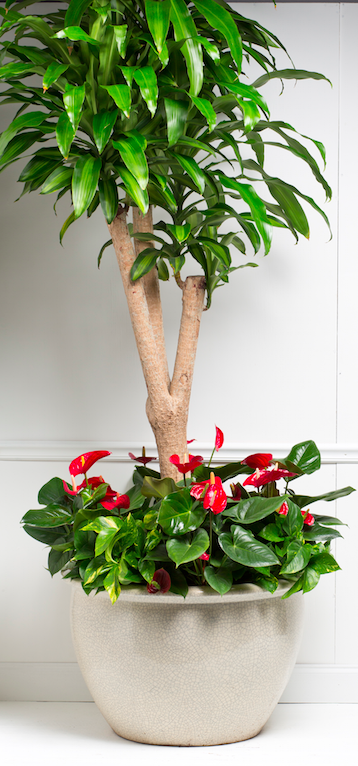
Beneath a large dracaena fragrant with lush 3-inch leaves, anthurium and golden pothos add vibrant color and purity to a space by combating the common indoor air pollutant, formaldehyde.
Filling The Space – Magnificently
Replace those winter blues and the void left by the festive Christmas tree with something large, breathtaking and healthy. The horticultural experts at Fifth Avenue Greenhouses in Fort Worth have oodles of ideas. Pictured: a large dracaena fragrans with lush 3-inch leaves that cascade gently above its gnarled, thick trunk. Underplantings of anthurium add enough vibrant color to liven up three rooms, while golden pothos quietly adds purity to the space by combating a common indoor air pollutant, formaldehyde.
Making A Statement
For the living room or den, where the family gathers, improve air quality with a mid-size artistic arrangement, or a matched set. The plantscaping design folks at Southern Botanical view interior plants as an intrinsic aspect of room decor and claim that, if planned and arranged well, they’ll improve moods as well as air quality. Pictured (top of page): superstars on NASA’s list of air purifiers, a red-edged dracaena marginata accented with green pothos ivy and an eye-catching patch of kalanchoe blooms.
Tabletop Art
Better than new wallpaper or a snazzy accent pillow, tabletop arrangements can define a homeowner’s personal style while bringing interest to any space. Dominating a coffee table, centering an outdoor living area or perched in a den near a favorite chair, a cheerful winter arrangement is a healthful and beautiful conversation piece. Plant specialists at places like Landscape Systems Garden Center and Calloway’s will design one on the spot, offering suggestions and care advice so that you leave with made-to-order living work of art. Examples include a
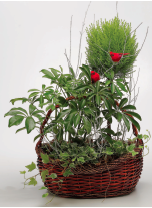
Landscape Systems’ “European Basket” pairs an umbrella plant with variegated ivy and lemon cypress. (Left) A Calloway’s arrangement features orchids with pink splash, hoya and Ming fern.
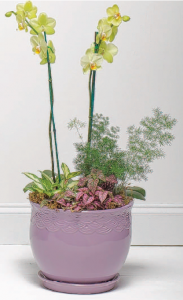 “European Basket” prepared by Landscape Systems pairs a Schefflera (often called an umbrella plant) with variegated ivy and lemon cypress. Decorative touches include tiny cardinals and glittering twigs, and floral manager Rob Haneisen says sphagnum moss placed over the roots easily “hides the mechanics” of the arrangement’s separate plastic containers. ($55-$60) Below, a casual, yet polished, creation from Calloway’s features dramatic orchids in a ceramic pot surrounded by pink splash, hoya and Ming fern. (Estimated price: $80).
“European Basket” prepared by Landscape Systems pairs a Schefflera (often called an umbrella plant) with variegated ivy and lemon cypress. Decorative touches include tiny cardinals and glittering twigs, and floral manager Rob Haneisen says sphagnum moss placed over the roots easily “hides the mechanics” of the arrangement’s separate plastic containers. ($55-$60) Below, a casual, yet polished, creation from Calloway’s features dramatic orchids in a ceramic pot surrounded by pink splash, hoya and Ming fern. (Estimated price: $80).
Sensational Succulents
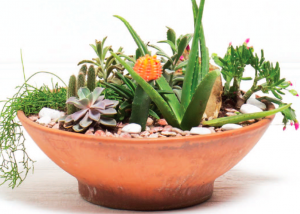
Healthy houseplants include succulents like aloe vera, echeveria, trailing pencil cactus and Christmas cactus.
With their dramatic looks and easy-care ways, succulents are popular and intriguing choices for interior plantscaping pieces large and small. Characterized by cushion like, columnar or spherical growth forms and a swollen, fleshy appearance of their stems and leaves, succulents store water and typically survive even the most neglectful of care. Shallow root systems are designed to collect scarce water supplies so they don’t require deep grow pots. Tabletop offerings include (left) a Southwest-themed collection from Calloway’s with aloe vera, echeveria, trailing pencil cactus, Christmas cactus and a jade plant.
Breathing green
As far back as the ’80s, NASA and the Associated Landscape Contractors of America have been studying the air-cleansing properties of various houseplants in space facilities, and, along the way, have developed several favorites that were found to be stellar performers.
Aloe: A sun-loving succulent, aloe grows well on a sunny window sill and takes on formaldehyde, common in cleaning products as well as toilet paper, tissues and personal care products. It also dislikes benzene, affiliated with ink and a frequent ingredient in glue, paint, plastics, detergent, chemical-based cleaners and more. As a bonus, the aloe gel squeezed from a cut leaf is a common remedy for cuts and sunburns.
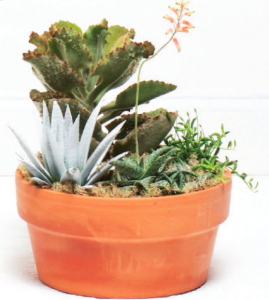
In a casual centerpiece from Fifth Avenue Greenhouses in Fort Worth, two air-purifying aloe veras — one wearing a trendy new plant-friendly paint — frame a large kalanchoe and a tall succulent cousin with a candelabra of tiny winter-flowering orange blooms.
Peace lily: Sitting atop NASA’s list for removing all three of the most common VOCs – formaldehyde, benzene and trichloroethylene – the Peace Lily calls for shade and weekly waterings, and is also credited with combating toluene and xylene, a solvent used in the leather, rubber and printing industries.
Gerbera daisy: This bright, flowering plant demands a sunny spot but repays your generosity by battling benzene and trichloroethylene, which comes home with the dry cleaning.
Golden pothos: Also known as devil’s ivy, golden pothos isn’t temperamental about light and looks fancy tumbling from a hanging basket or down the side of a planter. It’s considered a powerhouse for tackling formaldehyde.
Chrysanthemum: The colorful flowers of a mum can do a lot more than brighten a home office or living room; the blooms also help filter out benzene. This plant loves bright light, and to encourage buds to open, you’ll need to find a spot near an open window with direct sunlight.
Red-edged and Warneck dracaena: Adding a subtle a pop of color, red-edged dracaena takes on xylene, trichloroethylene and formaldehyde. With striped leaves forming clusters atop a thin stem, the Warneck variety reportedly grows well even without direct sunlight.
Weeping fig: A ficus in your living room can help filter out pollutants that typically accompany carpeting and furniture, such as formaldehyde, benzene and trichloroethylene. Caring for ficus can be tricky, but once you get the watering and light conditions right, they will last a long time.
Azalea: Bring this beautiful flowering shrub into your home to combat formaldehyde. Because azaleas do best in cool areas around 60 to 65 degrees, they’re a good option for improving indoor air in a cooler room of the house, if you can find a bright spot.
Bamboo palm: Also known as the reed palm, this small palm thrives in shady indoor spaces and often produces flowers and small berries. It tops the list of plants best for filtering out both benzene and trichloroethylene. It’s also a good choice for placing around furniture that could be off-gassing formaldehyde. Bamboo palms do best in 60-65 degrees, which makes them good choices for drafty, poorly insulated zones.
English ivy: Ever-popular with interior plantscapers, English ivy has been identified as a plant that reduces airborne particles from fecal matter. It has also been shown to filter out formaldehyde. Try one near your cat’s litter box, or maybe two.
Spider plant: With rich foliage and tiny white flowers, the spider plant is hard to kill and takes on benzene, formaldehyde, carbon monoxide and xylene.
Snake plant: Also known as mother-in-law’s tongue, this plant is one of the best for filtering out formaldehyde. A good choice for a bathroom, it thrives with low light and steamy, humid conditions, and helps fight air pollutants.
Resources



 “European Basket” prepared by Landscape Systems pairs a Schefflera (often called an umbrella plant) with variegated ivy and lemon cypress. Decorative touches include tiny cardinals and glittering twigs, and floral manager Rob Haneisen says sphagnum moss placed over the roots easily “hides the mechanics” of the arrangement’s separate plastic containers. ($55-$60) Below, a casual, yet polished, creation from Calloway’s features dramatic orchids in a ceramic pot surrounded by pink splash, hoya and Ming fern. (Estimated price: $80).
“European Basket” prepared by Landscape Systems pairs a Schefflera (often called an umbrella plant) with variegated ivy and lemon cypress. Decorative touches include tiny cardinals and glittering twigs, and floral manager Rob Haneisen says sphagnum moss placed over the roots easily “hides the mechanics” of the arrangement’s separate plastic containers. ($55-$60) Below, a casual, yet polished, creation from Calloway’s features dramatic orchids in a ceramic pot surrounded by pink splash, hoya and Ming fern. (Estimated price: $80).

